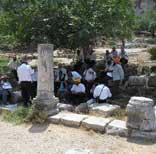In Jewish Sites
The Ancient Synagogue of Gush Chalav
The ancient synagogue of Gush Chalav is found in the upper Galil region of Israel
Gush Chalav, situated in the heights of the Galil region, is today an arab village called ‘Jish’, with approximately 2000 inhabitants, eighty percent of which are christian, the others muslim. The village, which exists on the site of the ancient Jewish town of Gush Chalav, dates back to the Second Temple period, the times of the Mishnah and Gemora, when its location was a central one in the Jewish world of the time. During that period, the surrounding area was known for its fine olives and olive oil, and even fine silks were found there.
In the village can be found remains from that period, in the form of remains from two synagogues, and also several burial sites of Tannaim and Amoraim, the most well-known of which are the graves of Shemaya and Avtalyon. Although remains have been found from two synagogues, however, only from one of them are the remains in such good condition.
The site of the synagogue and the building itself:
The ancient synagogue is located at the edge of the current village, in a pastoral area. It was built in a square shape, with its facade facing south (towards Yerushalayim), with that wall that held its one entrance having been built from hewn stones. Archaeological excavations have revealed the lower part of the lintel, on which is engraved an eagle with outstretched wings, holding a slingshot in its beak.
In the main hall there were originally three rows of pillars, corresponding to the three walls, as was usual in all synagogues of the Galil. What remains of them are the foundation of the eastern pillars and part of the western pillars. At the base of one of these pillars is engraved an enscription of dedication in Aramaic, which reads; “Yusa ben Nachum made this column – it should bring him blessing.”
The interior walls were coated with coloured plaster and benches were built against them. In the excavations, extensive tests were also carried out in the entire synagogue area, and to the surprise of the excavators, it emerged that the area was really a mound, and that there were many layers of settlement there, dating almost back to the Bronze Age, through the Iron Age, the periods of Persian and Roman rule, and up until the times of Arab rule.
At the site it is possible to detect refurbishments that took place to the synagogue over the years, such as the addition of a women’s section and the opening of an additional entrance to the structure.







